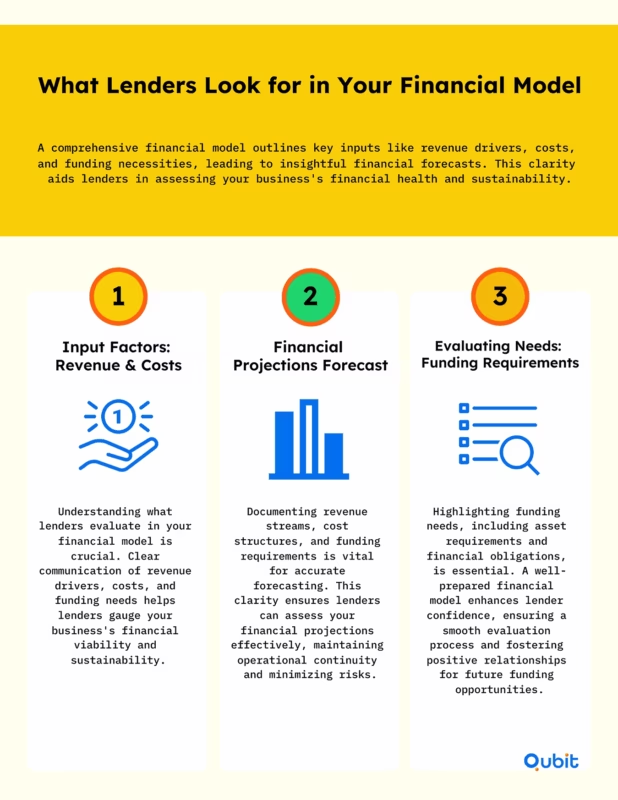When you're sitting across from a lender, your financial statements do most of the talking. Clean numbers, a clear story, and zero confusion—those are what get attention. Whether you're aiming to fuel your next growth phase or just need to smooth out cash flow, how you present your books can tip the scale in your favor.
This is especially true when you're eyeing debt financing as a way to move forward without giving up equity. Lenders want to see more than profits—they want proof that your business can handle the responsibility that comes with borrowing. In this post, we’ll break down what makes a financial statement lender-ready—and how to craft one that says, “You can bet on us.”
Ready to learn how to create a financial statement that stands out? Let’s jump right in.
What Financial Statements Do Startups Need?
Understanding the financial health of a startup begins with preparing essential financial reporting statements. These documents not only provide a snapshot of the company’s current position but also serve as critical tools for attracting investors and securing loans. Research shows that 82% of startup failures are linked to cash flow mismanagement, underscoring the importance of timely and accurate financial reporting. This section explores the four foundational financial statements every startup needs: balance sheets, profit and loss statements, cash flow statements, and break-even analyses.
Balance Sheet: A Snapshot of Financial Position
A balance sheet offers a comprehensive overview of what a company owns, owes, and its shareholder equity. It is divided into three main components: assets, liabilities, and equity. Assets include everything the company owns, such as cash, inventory, and equipment. Liabilities represent obligations like loans and accounts payable, while equity reflects the ownership interest in the company.
For startups, balance sheets are vital for assessing financial stability and determining whether the business can meet its short-term and long-term obligations. Additionally, real-world examples, such as the WSJ Balance, illustrate how startups can present their assets and liabilities effectively.
Profit and Loss Statement: Tracking Performance Over Time
The profit and loss (P&L) statement, also known as the income statement, details a company’s revenues, expenses, and profits over a specific period. This document is essential for evaluating operational efficiency and identifying areas for cost optimization. Startups can use P&L statements to demonstrate their ability to generate revenue and manage expenses, which is crucial when pitching to lenders or investors.
For example, a startup might use its P&L statement to highlight consistent revenue growth while showcasing efforts to reduce unnecessary expenditures. This transparency builds confidence among stakeholders and helps startups refine their financial strategies.
Cash Flow Statement: Monitoring Liquidity
Cash flow statements track the inflow and outflow of cash within a business, providing insights into its liquidity. Unlike the P&L statement, which focuses on profitability, the cash flow statement emphasizes the availability of cash to cover operational expenses, investments, and debt repayments.
Given that 82% of startup failures are linked to cash flow mismanagement, startups must prioritize accurate cash flow reporting. A detailed cash flow statement can help identify potential shortfalls and ensure that the business remains solvent.
Break-Even Analysis: Understanding Profitability Thresholds
A break-even analysis determines the point at which a startup’s revenues equal its expenses, signaling the transition from loss to profit. This tool is particularly useful for startups in capital-intensive industries, where upfront costs can delay profitability. For instance, Tesla reached its break-even point in 2018 after years of significant investments in production and infrastructure. On the other hand, Apple achieved profitability within two years by efficiently managing costs early on.
Startups can use break-even analyses to set realistic financial goals and adjust their strategies accordingly. This proactive approach ensures that founders remain focused on achieving sustainable growth.
Practical Tools and Templates for Startups
To simplify the process of preparing financial statements, startups can utilize templates and software designed for small businesses. These tools help ensure accuracy and consistency, making it easier to present financial data to lenders and investors. Examining the pros and cons of debt financing allows you to weigh its impact on your financial statements and overall funding strategy.
Why Financial Statements Matter for Lender Evaluations

Lenders rely heavily on financial statements to assess a startup’s creditworthiness and repayment capacity. A well-prepared balance sheet, P&L statement, and cash flow statement demonstrate financial discipline and transparency, increasing the likelihood of securing funding. Startups should also consider the types of startup funding available, as these decisions influence how financial statements are positioned to appeal to lenders.
By prioritizing accurate and timely financial reporting, startups can build credibility and lay the foundation for long-term success.
How to Build a Strong Financial Model for Your Startup
Creating a strong financial model is a cornerstone for startup success. It not only helps forecast growth but also plays a pivotal role in securing investment and preparing actionable financial statements. Understanding how to prepare a financial statement is essential for translating your projections into practical tools for lenders and investors.
Why Financial Models Matter
A well-constructed financial model serves as the foundation for strategic planning, enabling startups to anticipate financial needs and identify growth opportunities. Investors and lenders rely heavily on these models to assess the viability of your business. Without accurate projections, securing funding becomes significantly more challenging.
Approaches to Financial Modelling
Financial modelling combines two primary methods:
- Top-Down Forecasting: This approach starts with analyzing the market size and industry trends to estimate potential revenue. It’s particularly useful for understanding your startup’s position within the broader market.
- Bottom-Up Forecasting: This method focuses on internal metrics, such as operational costs, pricing strategies, and sales data, to build detailed projections. Bottom-up forecasting ensures your model reflects the realities of your business operations.
Integrating both approaches creates a comprehensive financial model that balances market potential with operational feasibility.
Key Outputs of a Financial Model
A robust financial model should produce several critical outputs:
- Projected Financial Statements: These include income statements, balance sheets, and cash flow statements, which are essential for demonstrating financial health.
- Break-Even Analysis: This helps identify the point at which your startup becomes profitable.
- Scenario Analysis: Incorporating multiple scenarios—such as base, worst, and best case—enhances credibility and showcases your ability to manage risks effectively.
For example, Scenario Analysis can be incorporated into the final decks shared with potential lenders, showcasing your preparedness for various market conditions.
Essential Inputs for Your Financial Model
To ensure accuracy, your financial model must include the following inputs:
- Revenue Drivers: These are metrics like pricing, sales volume, and customer acquisition rates.
- Cost Structure: Include both fixed and variable costs to provide a realistic view of expenses.
- Funding Requirements: Detail the capital needed to sustain operations and achieve growth milestones.
Preparing Financial Statements for Bank Loans
When preparing projected financial statements for bank loans, precision is key. Banks often scrutinize your income statements and cash flow projections to evaluate repayment capacity.
Here are some tactics to improve your chances:
- Highlight Revenue Stability: Demonstrate consistent revenue streams to reassure lenders of your ability to meet loan obligations.
- Incorporate Loan Repayment Scenarios: Show how different repayment structures align with your cash flow projections.
- Factor in Financing Options: Comparing convertible note vs equity can influence how you structure your financial statements for lenders.
Evaluating short-term vs long-term financing also helps determine the duration of funding that best complements your business goals.
Supporting Elements for a Strong Model
To further enhance your financial model, consider these supporting elements:
- Sensitivity Analysis: Test how changes in key assumptions impact your projections.
- Visual Representations: Use charts and graphs to make your data more accessible to stakeholders.
- Regular Updates: Continuously refine your model to reflect new data and market conditions.
By integrating these elements, your financial model becomes a dynamic tool for decision-making and investor communication.
Conclusion
Clear financial statements and robust models are essential tools for building trust with lenders. Throughout this blog, we’ve explored strategies to enhance credibility, from maintaining accurate records to presenting data in a transparent and professional manner. These practices not only improve your chances of securing funding but also set the foundation for long-term financial success.
We encourage you to adopt these tactics to strengthen your financial presentation and foster confidence among potential lenders. If you’re looking for expert guidance to refine your financial statements and secure funding, we at Qubit Capital are here to help. Explore our Fundraising Assistance services to get personalized support every step of the way.
Please specify the section type (e.g., Introduction, Main Section, FAQ, Conclusion, Key Takeaways) and provide the relevant data or outline for the section you'd like me to generate.
Please provide the specific section details (e.g., title, word count, keywords, internal links, etc.) so I can generate the content accordingly.
Key Takeaways
Robust financial statements are essential for establishing lender confidence.
Accurate balance sheets, profit and loss, and cash flow reports help mitigate cash flow mismanagement risks.
Financial models provide actionable forecasts that support strategic planning.
Scenario analysis and detailed projections further enhance credibility.
Frequently asked Questions
What financial statements are important for a start up entrepreneurial firm?
Each financial statement—balance sheet, profit and loss, cash flow, and break-even analysis—plays a distinct role in demonstrating a startup’s viability to lenders.


 Back
Back



